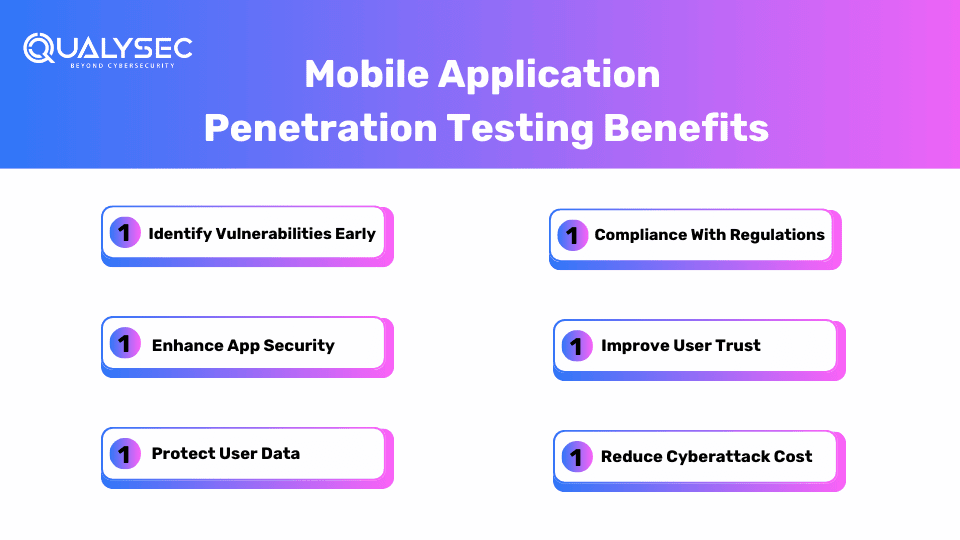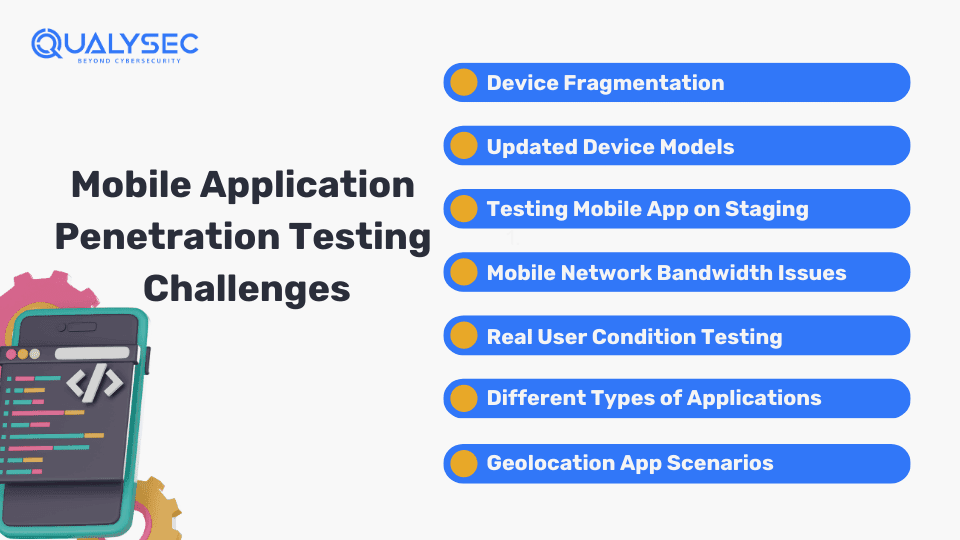Mobile application penetration testing helps businesses find and fix security flaws that hackers could exploit for their gain. Did you know, that in December 2022 alone, the number of global mobile app cyberattacks was approx. 2.2 million? This number keeps fluctuating, but millions of cyberattacks on mobile apps continue to happen regularly.
With technological advancement, attackers are developing new techniques to hack a mobile app and steal valuable information. This is why mobile application penetration testing and cybersecurity are now a must for all things digital, especially for mobile apps, since they store sensitive user data and often handle transactions.
This blog is going to discuss mobile app penetration testing, what it is, and how it is the secret weapon to keep the apps safe from cyber threats.
What is Mobile Application Penetration Testing?
Penetration Testing in Mobile Applications is conducted to analyze the security of mobile apps and their resilience against cyberattacks. The Google Play and Apple Store combined have nearly 6 million apps. To protect these apps from getting hacked, app manufacturers need regular security testing, in this case, penetration testing.
In pen tests, the testers, also referred to as “ethical hackers” simulate real-world attacks on the mobile app to identify security vulnerabilities. They even suggest methods to fix the found vulnerabilities. They examine the app’s code, network communications, and server interactions to identify weak points.
Penetration testers use various tools and techniques to break into the app just like a hacker would and conduct the tests. They check for security issues like code, network communications, and server interactions to identify weak points. The main goal of mobile app penetration testing is to ensure the app is secure and to protect user data from breaches.
Key Benefits of Mobile Application Penetration Testing
Penetration testing not only enhances the security of the apps but also indirectly increases revenue. There are plenty of benefits to conducting mobile application security testing, such as:
1. Identify Vulnerabilities Early
Penetration testing helps detect security flaws in mobile apps, such as coding errors, insecure data storage, and weak authentication mechanisms. This allows developers to address these specific issues before hackers exploit them.
2. Enhance App Security
By simulating real-world attacks, mobile penetration testing reveals the app’s security weaknesses. Developers can then implement the necessary security measures, making the app strong enough to prevent real hacking attempts.
3. Protect User Data
Mobile apps usually store sensitive user information like personal details, credit card info, and login credentials. mobile application penetration testing services help keep this data secure and ensure it is protected from unauthorized access and breaches.
4. Compliance With Regulations
Many industries, such as healthcare and finance require apps to comply with strict data protection standards. Penetration testing ensures the app meets regulatory requirements, such as GDPR, HIPAA, and PCI DSS.
Explore more about compliance here!
5. Improve User Trust
Users are more likely to trust apps that offer security. with regular mobile app penetration testing and addressing vulnerabilities, app manufacturers can assure users that their data is safe. As a result, it enhances user trust and retention.
6. Reduce Cost
By identifying and remediating security issues early through mobile application security testing, you can prevent costly data breaches. Additionally, you can minimize potential financial and reputational damage, and save money in the long run.
OS-Specific Mobile Application Penetration Testing
There are basically two main operating systems (OS) that rule the mobile app industry i.e. Android and iOS. Each has its own specific set of security rules and requires niche testing.
Android Penetration Testing
- Identify Platform-Specific Vulnerabilities: Android penetration testing focuses on identifying issues unique to the Android platform, such as improper use of Android permissions and insecure data storage.
- Test Third-Party Library Security: Android apps often rely on third-party libraries and penetration tests ensure these libraries are secure and do not expose the app to new vulnerabilities.
- Assess Application Components: Penetration testing evaluates the security of various Android components, including activities, services, and content providers.
- Verify Secure Data Transmission: Pen tests check if the app securely transmits data over networks. It prevents the app from interception and man-in-the-middle (MITM) attacks.
iOS Penetration Testing
- Identify Platform-Specific Vulnerabilities: iOS penetration testing helps find iOS platform-specific security flaws, such as improper handling of Keychain data, insecure PLIST files, and weaknesses in iOS sandboxing.
- Test Application Logic: Penetration testing checks the app’s logic to find any flaws that would result in unauthorized access or app data manipulation.
- Verify Secure Communication: It checks whether the app securely communicates with servers and other services. This prevents data interception and manipulation during transmission.
- Evaluate Code Obfuscation and Protection: The testing process examines the app’s code to ensure it is obfuscated and protected against reverse engineering. Thus, making it difficult for attackers to exploit the app.
How to do Security Testing for Mobile Applications?
Mobile application security testing or penetration testing is usually done by third-party service providers with expert “ethical hackers”. It is usually conducted in eight critical steps, such as:
- Information Gathering: The testing team gathers as much info about the app’s code and IT infrastructure as possible.
- Planning/Scoping: Then they plan the testing process, including what tools & techniques to use, what vulnerabilities to target, and what the client can expect from the test.
- Automated Vulnerability Scanning: First, the testers will use automated tools to scan for known vulnerabilities that are on the surface level.
- Manual Penetration Testing: Then they use manual techniques to test the app on a deeper level to identify vulnerabilities missed by the tools.
- Reporting: A pen test report is generated that includes several crucial elements, such as the vulnerabilities found, their severity level, and recommended remedial measures.
- Remediation: The development team uses this report to apply the recommended security measures. If they need to, the testing team helps them locate the vulnerabilities.
- Retest: The testing team retests the applications to evaluate the remediation and ensure no other vulnerability is present. A final pen test report is shared that includes the entire summary of the test.
- LoA/Security Certificate: Finally, the testing company provides the client with a letter of attestation (LoA), which is proof of the conduction of the mobile app penetration test. This certificate is usually shared with stakeholders and used for compliance needs.
Would you like to see a real mobile app pen test report? Click on the link below and download it immediately.
Latest Penetration Testing Report

Challenges in Mobile Apps Penetration Testing
Due to the increasing number of mobile-OS-browser combinations, there are several challenges for testers to be on top of their game. Some common mobile application penetration testing challenges include:
1. Device Fragmentation
Different mobile devices have different screen sizes, OS, and hardware configurations. This diversity makes it challenging to ensure that the app runs securely across all possible devices and requires extensive testing on multiple platforms.
2. Updated Device Models
Every other year a new model of a mobile device is released, each with updated software and hardware features. As penetration testers, it is challenging to keep up with these updates and also adapt their testing strategies to potential new vulnerabilities. Vulnerability Assessment plays an important role in identifying and addressing these evolving threats.
3. Testing Mobile App on Staging
Staging environments are usually different from production environments, leading to multiple security issues. It can be challenging to ensure that the app behaves equally in both environments. Also, the vulnerabilities found in the staging might not relate to real-world conditions accurately.
4. Mobile Network Bandwidth Issues
Mobile apps operate on various networks, such as 4G, 5G, and Wi-Fi. It is crucial to test the apps under different bandwidth conditions to identify network-related vulnerabilities. Additionally, it can be time-consuming and resource-intensive.
5. Real User Condition Testing
Simulating real user conditions, such as different network speeds, battery levels, and background app activity is very challenging. However, it is also important to accurately replicate these conditions during testing to uncover vulnerabilities that users might encounter in their daily use.
6. Different Types of Applications
Mobile apps come in various types, such as native apps, web apps, and hybrid apps. Each type has unique security challenges and requires different testing methodologies. Penetration testers must be experts in testing the security of all these applications to ensure total coverage.
7. Geolocation App Scenarios
Apps that use geolocation features, such as Google Maps, need to be tested for scenarios that involve data manipulation and spoofing. It is challenging to ensure the app’s security against these threats as simulating different geolocation scenarios is a time-consuming and tedious task.
Tools for Mobile Application Penetration Testing
Mobile application penetration testing is a combination of automated tools and manual techniques. These specialized tools identify known security vulnerabilities and range from comprehensive scanners to dynamic instrumentation frameworks. Some common Mobile application penetration testing tools include:
- Burp Suite: A comprehensive vulnerability scanner that is also used to identify security flaws in mobile applications.
- OWASP ZAP: An open-source security tool that helps find vulnerabilities in mobile apps by simulating various attack scenarios.
- MobSF (Mobile Security Framework): A versatile tool for automated security testing of mobile applications on Android and iOS platforms.
- Drozer: A tool that focuses on vulnerabilities specific to the Android operating system and allows security assessments of Android apps and devices.
- Frida: A dynamic instrumentation toolkit that analyses and modifies the behavior of mobile apps for security testing purposes.
- AppScan: IBM AppScan is a comprehensive penetration testing tool that identifies and mitigates vulnerabilities in mobile applications.
- QARK (Quick Android Review Kit): An open-source tool that identifies common security vulnerabilities in Android applications by analyzing the source code and APK files.
Want to conduct mobile app penetration testing? Qualysec has a robust team of expert ethical hackers who have all the necessary certifications and knowledge to find all possible vulnerabilities. We have secured over 450 applications for over 110 clients. Tap the link below and talk with our cybersecurity expert now!
Talk to our Cybersecurity Expert to discuss your specific needs and how we can help your business.
Conclusion
Research shows that there are 80+ apps installed on an average smartphone. If one of these app is hacked, the data and operations will be compromised. This is why mobile application penetration testing is now a must in every cybersecurity practice.
Since attackers are trying to find new ways to break the security of apps every day, pen tests help you stay one step ahead by finding and fixing weak points. Especially for mobile apps, as they store highly sensitive user data and handle monetary transactions. If you produce mobile apps, penetration testing is unavoidable.
Also Explore: Top mobile app security companies
FAQs
Q: What is the basis of penetration testing in Android?
A: Android penetration testing commonly includes:
- Gathering information about the app
- Using automated tools for vulnerability scanning
- Manual penetration testing for in-depth analysis
- Providing pen test report
- Retesting
- Providing final report and security certificate
Q: Which tool is used to test mobile applications?
A: There are different types of tools used to test mobile applications, such as:
- MobSF (Mobile Security Framework)
- Drozer
- Frida
- AppScan
Q: What is the cost of mobile application penetration testing?
A: The average cost of mobile app penetration testing ranges from $1,000 – $5,000. However, the mobile app pen testing costs vary from company to company and depend upon the complexity of the app.


































































































































































































































































































































































































































































































































0 Comments